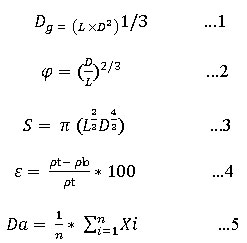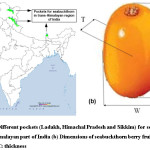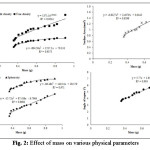Introduction
Seabuckthorn is known as a new botanicals of upcoming era because of its medicinal and nutritional properties (Stobdan et al., 2008). According to some researcher’s prediction, seabuckthorn is the “next major health food fad.” The nutritional and health potential of the fruit has been reviewed earlier in terms of nutraceutical and cosmoceutical applications (Bal et al., 2011). In India seabuckthorn is widely spread in the trans-Himalayan and North-East region (Figure 1). Economically the whole shrub of seabuckthorn is useful for the population living in the cold desert of Leh-Ladakh (Stobdan et al., 2012). Defence Institute of High Altitude Research (DIHAR) located in Leh-Ladakh has been working on seabuckthorn for their promotion, large scale cultivation and processing in order to develop this region economically by creating revenue and livelihood for the local population. Unfortunately post-harvesting practices for the picking of fruit from the thorny branches are so much disappointing and no mechanical tool is available for the picking. Therefore cost of harvesting is increased due to manual hand picking (Stobdan et al., 2012). In order to overcome this problem, it is necessary to develop mechanical tool which will enhance the safe and efficient picking without causing any damage to berries and branches of the shrub. Hence, study of physical properties of seabuckthorn berry is needed, which required for the design and development of suitable equipments for harvesting, post-harvest processing and material handling.
According to Khosnam et al., (2007), measurement of physical properties of agricultural and horticultural products is an important tool in design of sorting, grading, conveying, processing and packaging system. In another study, length, width, thickness, mass, volume and projected area was found to be the most important parameters in the sizing system (Mohsenin et al., 1986; Pelag and Ramraz, 1975; Khodabandhloo, 1999). Hence from the economic point of view, consumer prefers fruits and vegetable of uniform weight and size. Therefore study of relationship between weight and other sizing attributes is necessary (Storshine and Hamann, 1994). Shahbazi and Rahmati (2012), determine best (R2=0.98) and worst (R2=0.66) predicted mass model based on criteria projected area and thickness for fig fruit. Mass model based on volume was fitted perfectly with maximum coefficient (R2=0.91) for two Iranian apples varieties (Chakespari et al., 2010). Few researchers reported surface area based model for apple and nutmeg (Torabi et al., 2013; Lorestani et al., 2013). Soltani et al., (2011) developed model for banana fruit on the basis of geometrical attributes. Physical properties of other agricultural products were measured and reported by some other researcher; simarouba fruit and kernel (Dash et al., 2008), jatropha seed (Garnayak et al., 2008), yellow oleander fruit and kernel (Sahoo et al., 2009), mahua flower (Patel et al., 2011).
| Table 1: Physical properties of seabuckthorn fruit | |||||
| Parameter | Sample size(n) | Maximum | Minimum | Average | S.D. |
| Length (L), mm | 100 | 7.5 | 6.51 | 7.01 | 0.35 |
| Diameter (D), mm | 100 | 6.28 | 4.74 | 5.4 | 0.45 |
| 1000 berry weight (M), g | 1000 | 910.14 | 362.67 | 576.78 | 177.67 |
| Geometric mean (Dg), mm | 100 | 6.99 | 5.49 | 6.11 | 0.47 |
| Arithmetic mean (Da), mm | 100 | 6.247 | 6.173 | 6.19 | 0.42 |
| Surface area (S), mm2 | 100 | 154.76 | 76.87 | 114.44 | 25.71 |
| Aspect ratio (Ra), % | 100 | 83.73 | 72.81 | 76.98 | 2.83 |
| Angle of repose (Ө), degree | – | 6.82 | 3.59 | 4.99 | 1.03 |
| Sphericity (φ), % | 100 | 90.47 | 65.84 | 79.95 | 7.8 |
| Porosity (є), % | – | 60.07 | 17.05 | 37.93 | 12.38 |
| True density (ptd), kg.m-3 | 20 | 1399.24 | 647.19 | 951.33 | 195.34 |
| Bulk density (pbd), kg.m-3 | – | 725.88 | 453.81 | 621.29 | 80.81 |
| Moisture Content (M), % | 20 | 87.34 | 84.53 | 78.23 | 1.15 |
| Pulp, % | 50 | 88.82 | 87.90 | 88.36 | 0.65 |
| Seed, % | 50 | 12.10 | 11.18 | 11.64 | 0.65 |
| Pulp/Seed ratio, % | 50 | 7.95 | 7.26 | 7.60 | 0.48 |
Few studies has been carried out in the past on the physical properties of berries by Jarcau M., (2012) and Dwivedi et al., (2005). But, no such studies related to mass modelling of seabuckthorn have been reported. The aim of the present study was to develop most desirable model on the basis of measured physical properties for predicting berries mass on the basis of dimensions and surface area. In this study the correlation of various physical properties with respect to mass of the fruit has been studied. It also provides important information for researcher, horticultural product processor and food processor to design harvesting and processing tools.
| Table 2: Modelling based on mass | |||||
| Sr. No. | Models | Relation | Best suited Model | R2 | RSE |
| 1 | M= k1L + k2 | M= 0.51L – 2.96 | Exponential | 0.987 | 0.035 |
| 2 | M = k1D + k2 | M = 0.39D – 1.57 | Polynomial | 0.980 | 0.028 |
| 3 | M = k1L + k2D + k3 | M = 0.26L + 0.18D – 2.12 | Polynomial | 0.997 | 0.024 |
| 4 | M = k1Dg + k2 | M = 0.39Dg – 1.78 | Polynomial | 0.988 | 0.027 |
| 5 | M = k1S + k2 | M = 139.01S – 34.01 | Exponential | 0.963 | 5.554 |
Materials and Methods
Seabuckthorn berries were collected from the research farm of the Defence Institute of High Altitude Research (DIHAR) located in Leh-Ladakh. The berries were packed in polythene bags and transported to IIT, Delhi in ice containers. The berries were stored in the laboratory in deep freezer at – 25°C before start of the experiments. The principal dimensions, i.e. length (L) and diameter (D) of a hundred randomly selected seabuckthorn berries were measured by using a digital Vernier calliper of 0.01 cm least count (Fig. 1). From the principal dimensions, the geometric mean diameter (Dg) was calculated and is expressed as size. Berry mass was measured by using an electronic balance of 0.001 g sensitivity. To determine the 1000 berry mass, 100 randomly selected berries were weighed and extrapolated. The volume and true density of fruits and seeds were measured by liquid displacement method and toluene was used as the liquid. Porosity of bulk materials was calculated from bulk and true densities using their ratio in percentage (Mohsenin, 1986). The berry volume was measured using a 500 mL measuring cylinder. Arithmetic mean (Da) was calculated by dividing the diameter of all samples with the number of samples taken. The true density was calculated as the ratio of berry mass by volume. The seed to pulp ratio was also calculated from the berry and seed masses. The oil was extracted from pulp using solvent extraction method (soxhlet). The size, sphericity (φ), surface area (S), porosity (є), bulk density and true density were computed using the following equations 1-5 (Kingsly et al., 2006; Topuz et al., 2005):

Modelling of seabuckthorn fruit
In the present study all physical parameters based on mass and surface area were studied to develop models. Five models system namely linear (6), power (7), polynomial (8), exponential (9) and logarithmic (10) were used to predict best model for seabuckthorn fruit.
a = k1b + k2 …………………… (6)
a = k1bk2 …………………………. (7)
a = k1 + k2b + k3b2 ……………… (8)
a = k1ek2b ……………………… (9)
a = k1ln (b) + k2 ………………… (10)
Where, ‘a’ is dependent variable for mass (M) and Surface area (S) determination
‘b’ is independent variable for physical characteristics
k1, k2, k3 are regression coefficient
Statistical analyses
MS-office (excel spreadsheet) was used to analyse physical property data. All values are reported in the form mean ± SD. Statistical analyses for correlation between physical properties and regression modelling was done by using the same software.
| Table 3 Modelling based on surface area | |||||
| Sr. No. | Models | Relation | Best suited Model | R2 | RSE |
| 1 | S= k1L + k2 | S = 70.24L – 378.3 | Power | 0.948 | 6.53 |
| 2 | S = k1D + k2 | S = 59.34D – 205.5 | Polynomial | 0.947 | 5.86 |
| 3 | S = k1L + k2D + k3 | S = 29.53L + 34.76D -288.53 | Exponential | 0.979 | 5.79 |
| 4 | S = k1Dg + k2 | S = 57.9Dg – 236.3 | Polynomial | 0.981 | 4.38 |
| 5 | S = k1M + k2 | S= 145S + 31.1 | Polynomial | 0.932 | 5.42 |
Result and Discussion
The average, minimum, maximum and standard deviation values of the studied physical parameters are given in Table-1. All the measurements of physical parameters were taken on fresh weight basis. The length, diameter, thousand berry weight, geometric mean diameter, arithmetic mean diameter, surface area, aspect ratio, angle of repose, sphericity, porosity, true density, bulk density, moisture content were found in the range of 6.5-7.5, 4.74-6.28, 362.67-910.14, 5.49-6.99, 6.17-6.24, 76.87-154.76, 72.81-83.73, 3.59-6.82, 65.84-90.47, 17.05-60.07, 647.19-1399.24, 453.81-725.88, 84.53-87.34 respectively. Due to variation in dimensions and mass in fruit, some major difference was observed in the measured values of thousand berry weight, surface area, angle of repose, sphericity, porosity, true density, bulk density. Hence, relation between mass and other physical parameters (true density, bulk density, sphericity, porosity, surface area and angle of repose) were also studied in order to observe coefficient of determination (R2) and best suited equation.
 |
Figure 1: (a) Different pockets (Ladakh, Himachal Pradesh and Sikkim) for seabuckthorn in trans-Himalayan part of India (b) Dimensions of seabuckthorn berry fruit, L: length, W: width, T: thickness Click here to View figure |
Some other physicochemical parameters namely percent seed, percent pulp, pulp to seed ratio and percent oil were also determined which is important from the economic point of view. Extraction of oil from pulp was carried out by solvent extraction method. Two hour extraction procedure was followed by using hexane and ethanol as extraction solvent in 1:1 ratio. 3.6% yield of oil was obtained on fresh weight basis. In earlier report range of percent of oil yield from pulp and seed was reported to be 1.5-3.5 and 9.9-19.5 respectively (Stobdan et al., 2008).
Variation of physical properties
Seabuckthorn is a highly perishable and delicate fruit due to its soft texture. Its physical parameter like diameter is greatly affected by than length, which is in agreement to previous reports (Jarcau M., 2012). Mass is an equally important factor with moisture which play an important role in post-harvest processing of fruits and vegetables. Present study includes the effect of mass on some important physical characteristics as shown in figure 2. Sphericity and porosity results show that as the mass increases sphericity and porosity increases. Polynomial equations 11 and 12 were fitted best for sphericity and porosity with highest R2 0.971 and 0.960 respectively.
 |
Figure 2: Effect of mass on various physical parameters Click here to View figure |
y = -80.48x2 + 140.31x + 28.179 ———– (11)
y = -15.72x2 + 87.436x – 6.7964 ———– (12)
Values for true and bulk density was also found to be directly proportional with the increasing mass. Logarithmic and polynomial equation with highest R2 0.915 and 0.937 was found to be fitted best for true and bulk density respectively (Eq. 13 and 14).
y = 608.92ln(x) + 1313.3 ———– (13)
y = -894.56x2 + 1517.1x + 70.331 ———– (14)
results for angle of repose was linearly correlated with mass while polynomial relation was found between mass and surface area as shown in following equation 15 and 16. R2 recorded for equation 11 and 12 were 0.993 and 0.959 respectively. Strong correlation with highest coefficient of determination was observed between mass and angle of repose, while mass and true densities were found to be poorly correlated.
y = 5.77x + 1.658 ———– (15)
y = -0.8127x2 + 2.4079x + 0.0443 ———- (16)
Modelling based on mass and surface area
Model was prepared based on mass using dimensions of the seabuckthorn fruit like length, diameter, geometric mean and surface area (Meisami-asl et al., 2009). The developed models are shown in Table-2. The best among the 5 models prepared was the polynomial model with R2 of 0.997 and RSE of 0.024. This model indicates strong effect of length and diameter on the mass of berries. Among the single variable regression models, the polynomial model between mass and geometric mean had highest R2 (0.988) and RSE of 0.027. Surface area based model with respect to dimensions and mass were developed and shown in Table 3. The best model among the single and multiple regression model was the polynomial model between surface area and geometric mean diameter giving highest R2 = 0.981 and RSE = 4.38.
Conclusion
- The shape of seabuckthorn berry was found to be somewhat ovoid. 3.6% of oil yield was obtained from seabuckthorn berry pulp.
- Correlation between mass and other physical attributes (true density, bulk density, sphericity, porosity and angle of repose) were studied. Sphericity, porosity and bulk density varied with fruit mass and followed polynomial regression equations. However, angle of repose and true density were related to mass in linear and logarithmic equations respectively.
- In modelling study, 5 mass based model were studied and the polynomial model was best suited with highest R2 = 997 and RSE = 0.024. This model indicates strong correlation between length and diameter on the mass of berries.
- The best model among the single and multiple regression model was the polynomial model between surface area and geometric mean diameter giving highest R2 = 0.981 and RSE = 4.38.
- This study concludes that mass model is fitted best from economic point of view for further study.
Acknowledgements
First author thanks to Council of Scientific and Industrial Research (CSIR), Government of India for providing financial support through CSIR-RA Post-Doctoral Fellowship [Grant no. 09/086(1268)/2017-EMR-I] to carry out present research work.
References
- Stobdan T., Angchuk D., Singh S.B. Seabuckthorn: An emerging storehouse for researchers in India. Current Science; 94(10):1236-1237:(2008).
- Bal L.M., Meda V., Naik S.N., and Satya S. Sea buckthorn berries: A potential source of valuable nutrients for nutraceutical and cosmoceuticals. Food Research International; 44:1718-1727:(2011).
CrossRef - Stobdan T., Korekar G., Chaurasia O.P., Balaji B., Yadav A., Dwivedi S.K., Targais K., Mundra S., Srivastava R.B. Seabuckthorn production for greening and sustainable income generation in cold desert of India. In: Innovatives in Agro Animal Technologies (Eds R.B. Srivastava, W. Selvamurthy). Satish Serial Publishing House, New Delhi, India:(2012).
- Khoshnam F., Tabatabaeefar A., Ghasemi Varnamkhasti M., Borghei A. Mass modelling of pomegranate (PunicagranatumL.) fruit with some physical characteristics. Scientia Horticulture; 114:21–26 :(2007).
CrossRef - Mohsenin N.N. Physical Properties of Plant and Animal Materials-II. Gordon and Breach SciPubl, New York. 1986.
- Pelag K., Ramraz Y. Optimal sizing of citrus fruit. Trans ASAE. 1975;18(6):1035-1039.
CrossRef - Khodabanbandehloo H. Physical properties of Iranian export apples. M.Sc. Thesis, University of Tehran, Karaj, Iran. 1999.
- Stroshine R., Hamann D.D. Physical properties of Agricultural Materials and Food Products. Course Manual, Purdue University Press, USA. 1994.
- Shahbazi F., Rahmati S. Mass modelling of fig (Ficus carica L.) fruit with some physical characteristics. Food Science and Nutrition. 2012;1(2):125-129.
CrossRef - Chakespari A.G., Rajabipour A., Mobli H. Mass modelling of two apple varieties by geometrical attributes. Australian Journal of Agricultural Engineering. 2010;1(3):112-118.
- Torabi A., Tabatabaekoloor R., Hashemi S.J. Volume modeling of three apple varieties based on physical parameters. International Journal of Agriculture and Food Science Technology. 2013;4 (5):461-466.
- Lorestani A.N., Nazaripour Z., Haghighi S. Mass Modeling of Nutmeg (Myristica fragrans) with some physical characteristics. International Journal Agriculture and Crop Sciences. 2013;5-11:1183-1185.
- Soltani M., Alimardani R., Omid M. Modeling the main physical properties of banana fruit based on geometrical attributes. International Journal of Multidisciplinary Science and Engineering. 2001;2(2):1-6.
- Dash A.K., Pradhan R.C., Das L.M., Naik S.N. Some physical properties of simarouba fruit and kernel. International Agrophysics. 2008;22:111-116.
- Garnayak D.K., Pradhan R.C., Naik S.N., Bhatnagar N. Moisture-dependent physical properties of jatropha seed (Jatropha curcas ). Industrial Crops and Products. 2008;27:123-129.
CrossRef - Sahoo N.K., Pradhan S., Pradhan R.C., Naik S.N. Physical properties of fruit and kernel of Thevetia peruviana : a potential biofuel plant. International Agrophysics. 2009;23:199-204.
- Patel M., Pradhan R.C., Naik S.N. Physical properties of fresh mahua. International Agrophysics. 2011;25:303-306..
- Jarcau M. Some physical properties of seabuckthorn and hoe the packing conditions influence them. Food and Environment Safety. 2012;;11(4):36-42:.
- Dwivedi S.K., Singh R., Ahmed Z. Morpho-biochemical characteristics of seabuckthorn (Hippophae rhamnoides) growing in cold arid Ladakh (India). In Seabuckthorn Multipurpose Wonder Plant. Biochemistry and Phramacology, II, New Delhi. 2005.
- Kingsly A.R.P., Singh D.B., Manikantan M.R., Jain R.K. Moisture dependent physical properties of dried pomegranate seeds (Anardana). Journal of Food Engineering. 2006;75(4):492-496.
CrossRef - Topuz A., Topakci M., Canakci M., Akinci I., Ozdemir F. Physical and nutritional properties of four orange varieties. Journal of Food Engineering. 2005;66:519–523.
CrossRef - Meisami-asl E., Rafiee S., Keyhani A., Tabatabaeefar A. Some physical properties of apple cv. “Golab”, Agricultural Engineering International. 2009;11:1124.

This work is licensed under a Creative Commons Attribution 4.0 International License.






